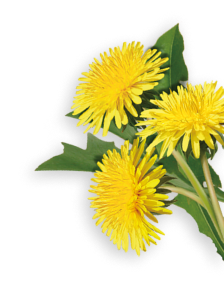
More Dandelion info
An underestimated “weed” with herbal prowess.

Dandelion’s benefits are often overlooked as most gardeners consider it a common garden weed. However, it is actually one of the great medicinal plants of Traditional European Herbalism. Dandelion root is rich with inulin and other prebiotic starches that feed healthy gut bacteria, while other herbal compounds within dandelion’s leaves support kidney function.*
The bitter flavor of dandelion, produced by sesquiterpene lactones, helps prepare the body for digestion. Tasting the bitter flavor promotes digestion while also stimulating the elimination of bile from the gallbladder.* Healthy elimination is vital, which is why dandelion’s action as a gentle diuretic can help support the body’s natural detoxification processes. In other words, dandelion tea makes you pee.*

While the first puffy blooms of dandelion likely dotted landscapes in obscurity, the first known mention of dandelion as a medicinal herb is in Arabic texts dating to the 10th century. By the 13th century, it was mentioned in a Central European herbal text alongside 180 other medicinal plants and was primarily credited with a beneficial effect for the eyes. While common modern uses tend towards its effects on urinary, detoxification and hepatic functions of the body, it’s clear early practitioners and scholars were beginning to see dandelion as more than a common wildflower.*
More than an herbal medicine, over time humans quickly discovered the culinary appeal of dandelion from flower to root. Various cultures brewed the roots to make a slightly sweet and bitter tea or broth, fermented them into a hearty “root beer,” and dried, roasted and ground them into a rich powder for a robust “coffee-like” beverage. Others learned to harvest the young spring leaves to add to soups, juices, and salads. The yellow “petals” can be plucked from the head of the dandelion and sprinkled over salads, brewed into golden dandelion wine, transformed into a “honeyed syrup,” or kept intact as a blossom to batter and fry into crispy fritters.

Dandelion is a small perennial from the Asteraceae family that grows well in soils of all types—a quality that makes this plant so resilient, adaptable and widespread. Although a native of Europe and Western Asia, dandelion is now naturalized in many countries around the world. It attracts pollinators and earthworms and loosens the soil with its strong, deep roots.
Key identifiers for finding a “true” dandelion, as there are many Asteraceae look-alikes, is the singular, hollow stem attached to each bright yellow flower. When picked, the stem produces a drippy white substance that is actually a form of latex. Many yellow dandelion look-alikes will have multiple flowers branching off the same stem.
Another trait specific to dandelion is its jagged, hairless leaves, which earned it the name, dent de lion, meaning “lion’s tooth” in French and Spanish. Its round yellow flower has inspired others to call it “swine snout.” But it is dandelion’s botanical name of Taraxacum officinale, which speaks more favorably to the herb’s true purpose, in some translations as “healing herb.”
The medicinal parts are dried leaves harvested before the flowering season; the root collected and dried in autumn; the aerial parts and the rhizome harvested before the flowering season and then dried.
Products that contain Dandelion
Roasted Dandelion Root Tea
Dandelion Leaf & Root Tea
Additional Information
Important Precautions:
Warnings – do not use if you have kidney disease, diabetes, or heart failure, or if you are allergic to plants in the daisy (Asteraceae) family.
Contrindications – consult your health care practitioner prior to use if you have liver or gallbladder disorders, bowel obstruction or of you are pregnant or breastfeeding.
Dandelion should be consumed for a period of 2 weeks, followed by a break before resuming.
Legal Disclaimer:
The information and other content in this article are designed to provide a general overview of the botany, cultural history, and traditional uses of this herb. It is not intended and should not be construed as health advice. Every person is unique and you should consult with your health care provider before using any herbal product or supplement.

Become an Herb Nerd & Get 10% Off!
Herbal tidbits, DIY plant projects, exclusive discounts, and recipes to follow the seasons delivered straight to your inbox.





